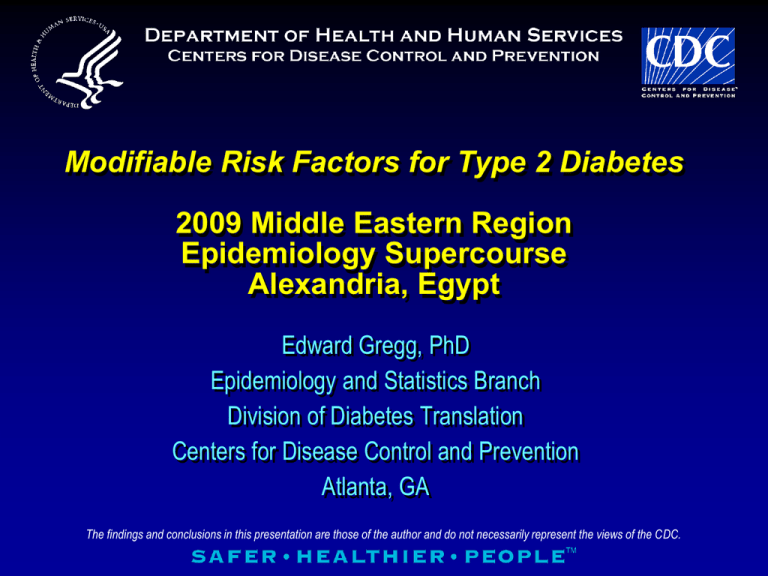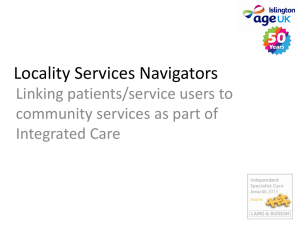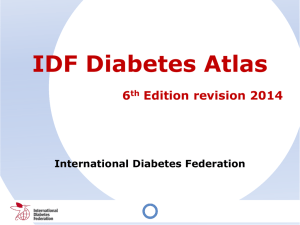
Modifiable Risk Factors for Type 2 Diabetes
2009 Middle Eastern Region
Epidemiology Supercourse
Alexandria, Egypt
Edward Gregg, PhD
Epidemiology and Statistics Branch
Division of Diabetes Translation
Centers for Disease Control and Prevention
Atlanta, GA
The findings and conclusions in this presentation are those of the author and do not necessarily represent the views of the CDC.
Key Steps in the Public Health Research Leading to
Public Health Decision Making
Surveillance and Descriptive Epidemiology
• Monitor health of the population
• Identify public health problems and their magnitude
• Evaluate levels of care
• Identify high risk populations amenable to intervention
Analytic and Clinical Epidemiology:
• Identify modifiable risk factors
• Examine effectiveness of interventions in the clinical setting aimed at the
individual
Health Services Research, Cost-Effectiveness, Translation Research
• Examine the effectiveness of different health service, program, or policy-level
•
interventions.
Examine the cost effectiveness of successful interventions
Range of Potential Priorities in the Public Health Response to Diabetes
Normal
IGT
Type 2 DM
Primary
prevention
Secondary
prevention
Complications
Disability
Death
Tertiary
prevention
Control of complications and management of disability.
Prevention of diabetes complications
Assure access to care
Prevention of diabetes among persons of high risk.
Prevention and management of risk factors in the whole
population.
Common Study Designs Used in Epidemiologic Research
Observational Studies
• Cross-sectional
• Retrospective (case control)
• Prospective (cohort studies)
• Ecologic Studies
cross-sectional
Retrospective
cohort
Intervention Studies
• Quasi-experimental studies
• Controlled intervention studies
Clinical
o Health Service
o Community
Cost-effectiveness studies
o
•
Intervention
Yes
No
Risk factors: Characteristic of an individual or his/her environment
that increases the chance of a health-related condition.
Major Types:
•
•
•
•
•
•
Causal vs non-causal
Modifiable vs non modifiable
Behavioral
Physiologic
Environmental
Contextual
How do we use risk factors?
To contribute to understanding of etiology of
disease.
To guide the development of effective
interventions.
Bradford Hill Criteria for Evaluation of
the Evidence of Causality
Strength of Association
Dose-response effect
Temporality
Consistency of evidence
Biological plausibility
Specificity of association
Experimentation
How do we use risk factors?
To contribute to understanding of etiology of
disease.
To guide the development of effective
interventions.
To assist in efficient identification of people
who will benefit from intervention.
Step 1: Clinical Observations/Impressions
“There are entirely too many diabetic patients in the country.
Statistics for the last thirty years show so great an increase
in the number that, unless this were in part explained by a
better recognition of the disease, the outlook for the future
would be startling.”
”The physician should take pride in the prevention of diabetes
in his practice. Obese patients should be frankly told that
they are candidates for diabetes”.
”But it is to the diabetic patient and his relatives that one can
look most confidently for help in preventing diabetes. They
should be encouraged to disseminate information about its
prevention”.
Joslin EP.
The Prevention of Diabetes Mellitus
JAMA 1921; 76 (2):79-84.
Kahn et al., Nature, 2006
Evidence from observational
epidemiology:
Ecologic Studies
Migration Studies: Association Between Westernization and Diabetes
Prevalence in Susceptible Populations
40
%
30
20
10
Nauru
New
Guinea Australian
Aborigines
Chinese
King, Diabetes Care, 1993; 1998; Diamond J, Nature, 2003
l In
di a
Ur
ba
nI
nd
ia
Ur
ba
nF
iji
Ru
ra
Ta
iw
an
ore
l
Sin
ga
p
Ru
ra
Tr
ad
it io
na
We
l
st e
rni
ze
d
n
l
Ur
ba
Ru
ra
20
00
19
52
0
Indian
Schulz et al., Diabetes Care, 2006
Natural Experiments
Franco et al.,
Am J Epidemiol, 2007
Clues from Descriptive Epidemiology
10
Diabetes Prevalence among U.S.
Adults Aged 20 - 74
8.83%
1.37
8
BMI Category
1.42
6
5.03%
2.26
4
0.4
0.56
1.05
1.5
2.5
1.57
1.28
1976-1980
1999-2004
Obese III (> 40)
Obese II (35-40)
Obese I (30 -35)
Overweight (25 -30)
2
Normal / underweight
(<25)
Total
Age and sex adjusted
0
Year
Trends in the proportion of total intake devoted to macronuetriends
(left x-axis) and mean total Energy Intake (right x-axis) among U.S.
adults age 20-74, 1971 to 2000
60
Total Intake (kcals)
2800
2600
50
2400
40
2200
% Carbs
2000
30
% fats
% saturated fats
1800
% protein
Total Energy
20
1600
1400
10
1200
0
1000
1971-1974
MMWR, 2004
1976-1980
1988-1994
1999-2000
Percentage of total carbohydrates obtained from whole grains
(smaller circles) and corn syrup (larger circles) in the United States
Gross et al., Am J Clin Nutr, 2004
Trends in % of Meals Eaten at Home and Trends in Total
Kcal Intake in Meals and Snacks in the U.S., 1977-1996.
Snacks
75
Meals
1950
70
kcals/day
% Meals eaten at home
80
65
60
55
50
1977-
1989-
1994-
78
91
96
Nielsen and Popkin, JAMA, 2003
1800
1650
1500
1977-
1989-
1994-
78
91
96
Food intake per occasion, oz
Portion Sizes for Selected Key Foot Items for
Americans Aged 2 and Older, 1977-1996.
25
20
15
10
5
Sa
l
ty
sn
ac
ks
De
ss
er
So
ts
ft
dr
in
Fr
ks
ui
t
dr
Fr
in
en
ks
ch
Fr
H
ie
am
s
bu
rg
er
s
Pi
zz
a
M
ex
ic
an
0
Nielsen and Popkin, JAMA, 2003
1977-78
1989-91
1994-98
Summary of Secular Trends in
U.S. Dietary Behavior
Healthy Trends
•
•
•
•
Lower % of saturated fat
Lower % of total fat in diet
Higher % of
carbohydrates
More fruits and
vegetables
Unhealthy Trends
•
•
•
•
•
•
Increased portion sizes
Decreased quality of carbs
Increased total intake
More meals out of the
home
Increased soda intake
Reduced breakfast
frquency
Luckovich, Atlanta Journal Constitution
Trends in Leisure-Time Physical Inactivity by Age, Sex, and
Race/Ethnicity - United States, 1994-2004
Centers for Disease Control and Prevention, MMWR, 2005
Evidence from Cohort Studies and
Analytic Epidemiology
Body Mass Index and 1-year Risk of Diabetes
(Ford ES et al. AJE 1997;146:214-22)
BMI 1-y Risk (%)
<22
0. 224
22-<23
0. 255
23-<24
0. 428
24-<25
0. 539
25-<27
0. 553
27-<29
0. 899
29-<31
1.074
31-<33
1.480
33-<35
1.892
35+
2.461
%- Point
Increase per
RR Absolute Increase 100,000
0
0
1
0.031
31
1.18
0.204
204
2.44
0.315
315
2.97
0.329
329
3.04
0.675
675
5.07
0.850
850
5.70
1.256
1,256
8.21
1.668
1,668
10.89
2.237
2,237
14.64
Cumulative
Increase
0
550
1,554
7,565
Relative risk of incident diabetes per standard deviation of BMI and
Waist circumference from a meta-analysis of 32 studies
Vasquez, Epidemiol Rev, 2007
Hu et al.,
Arch Intern Med, 2001
Potential Impact of Physical Activity on Diseases and Conditions:
Across the Life Span
Adolescent -
10
20
Young Adult -
30
Adult -
40
50
Mid-aged -
60
Older Adult -
70
80
Lifestyle forming, habituation, and maintenance
Obesity
Diabetes
CVD
Physical
Function
Falls
Fracture
Stroke
Cancers
Quality of life / Mental health
90
Dietary factors as independent diabetes risk
factors
Characteristics of fat intake
Whole grain / cereal fibers
Dairy
Glycemic load
“Western diet”
Fast food intake
Soda intake
Alcohol intake
Coffee consumption
Diabetes OR per 1kg
Birth weight=0.78
Gestational Diabetes and the Incidence of Type 2 Diabetes:
A systematic review (Kim et al., Diabetes Care, 2002)
Systematic Review of the Incidence of Diabetes
Associated with Various Categories of Glycemia
Number Regress to
of studies normal
(median %)
26
8%
Progress to Relative Risk of
Diabetes
Diabetes
(median %)
7%
6.4 (4.9 – 7.8)
IGT Isolated
3
n/a
6%
5.5 (3.1 – 7.9)
IFG
6
13 – 29%
5-20%*
4.7 (2.5 – 6.9)
IFG Isolated
3
n/a
7%
7.5 (4.6 – 10.5)
IGT and IFG
3
n/a
10-15%
12.1 (4.3 – 20)
Impaired Glucose
Tolerance
Gerstein et al., Diab Res Clin Pract, 2007
*extremely variable; 1-7% in
European pops; 23-34% in Asian pops.
Non-Traditional Risk Factors
Serum Concentration
ND
Cases/n
<25%
25-50%
50-75%
75-90%
90-100%
2/643
34/505
53/527
65/275
63 / 246
Prevalence
--
0.4
6.7
10.1
23.6
25.6
Adjusted
OR
--
Referent
14.9
(3. 0 – 65.0)
14.7
(3.4 – 63.9)
38.2
(8.0 – 183.1)
37.7
(7.8 – 182.0)
Adjusted
OR
---
0.07
(0.02 – 0.33)
Ref
1.1
(0.6 – 1.7)
2.7
(1.5 – 4.9)
2.7
(1.5 – 4.8)
Lee et al., Diab Care, 2007
Upstream / Contextual Factors as Risk
Factors for Obesity and Diabetes
Poverty
Education
Food
insecurity
Food
environment
Neighborhood
factors
County-level Estimates of Diagnosed Diabetes for Adults
aged ≥ 20 years: United States 2005
Summary: Risk Factors for Type 2 Diabetes
Age ↑
Family History ↑
Gestational Diabetes ↑
Obesity / fat distribution ↑
Physical Activity / fitness ↓
Smoking ↑
Very low birth weight ↑
Depression ↑
Antipsychotic medications ↑
Anti-Retrovial therapy ↑
Dietary Factors
• Carbohydratess ↓
• Fats ↑↓
• Glycemic load ↑
• Cereal fiber / whole grain ↓
• Dairy products ↓
• High fructose corn syrup ↑
• Sugar-sweetened bevarages ↑
• Alcohol ↓
• Coffee ↓
Major Type 2 Diabetes Risk Factors Under
New (or Renewed) Investigation
Genetic markers
Insulin resistance biomarkers (inflammation markers,
adipocytokines, hepatocytokines)
Sleep; sleep apnea
Depression; vital exhaustion
Vitamin D deficiency
Anti-retroviral treatment
New antipsychotic treatment
Fatty liver disease
Hepatitis
Proportion of Participants Developing Diabetes During
the Finnish and U.S. Diabetes Prevention Studies
Finland
50
United States
50
40
40
Control
30
Control
Metformin
%
%
30
20
Lifestyle
20
Lifestyle
10
10
0
0
0
1
2
3
4
5
6
0 0.5 1 1.5 2 2.5 3 3.5 4
Study Year
Tuomilehto, N Engl J Med, 2001; DPP Research Group, N Engl J Med, 2002
Study Year
Characteristics of Controlled Trials of Lifestyle-based
Interventions on Diabetes Incidence
Risk status
Mean
BMI
Net
Weight
change
Relative
Risk
6
IGT
26
1.8 kg
0.56
Finland, 2001
3
31
-2.5 kg
0.42
DPP, USA,
2002
3
IGT,
BMI > 25
IGT
BMI > 24
IGT
34
-5.2 kg
0.42
24
-1.8 kg
0.33
IGT
26
-0.3 kg
0.72
Followup
Da Qing,
China, 1997
Kosaka, Japan 4
2004
IDPP,
3
India, 2006
Pan et al., 1997; Tuomilehto et al., 2001, Knowler et al., 2002
Application of Risk Scores to Public Health Intervention
Diabetes
incidence, %
100
90
80
70
60
50
40
30
20
10
0
Men
Women
Application of Risk Scores to Public Health
Intervention
0 1 2 3 4 5 6 7 8 9 10 11 12 13 14 15 16 17 18 19 20
Risk Score
Applications of Risk Scores to Diabetes Prevention in Finland And Germany
Schwarz, Horm Metab Res, 2008
Discussion Questions
Are the modifiable risk factors in your country and region
likely to be different from these?
• For the average individual?
• As predictors of trends over time?
If yes, what would those risk factors be?
What major types of research are needed in your country to
examine new and emerging risk factors?
What are the major candidate interventions for publication in
your country and region?









